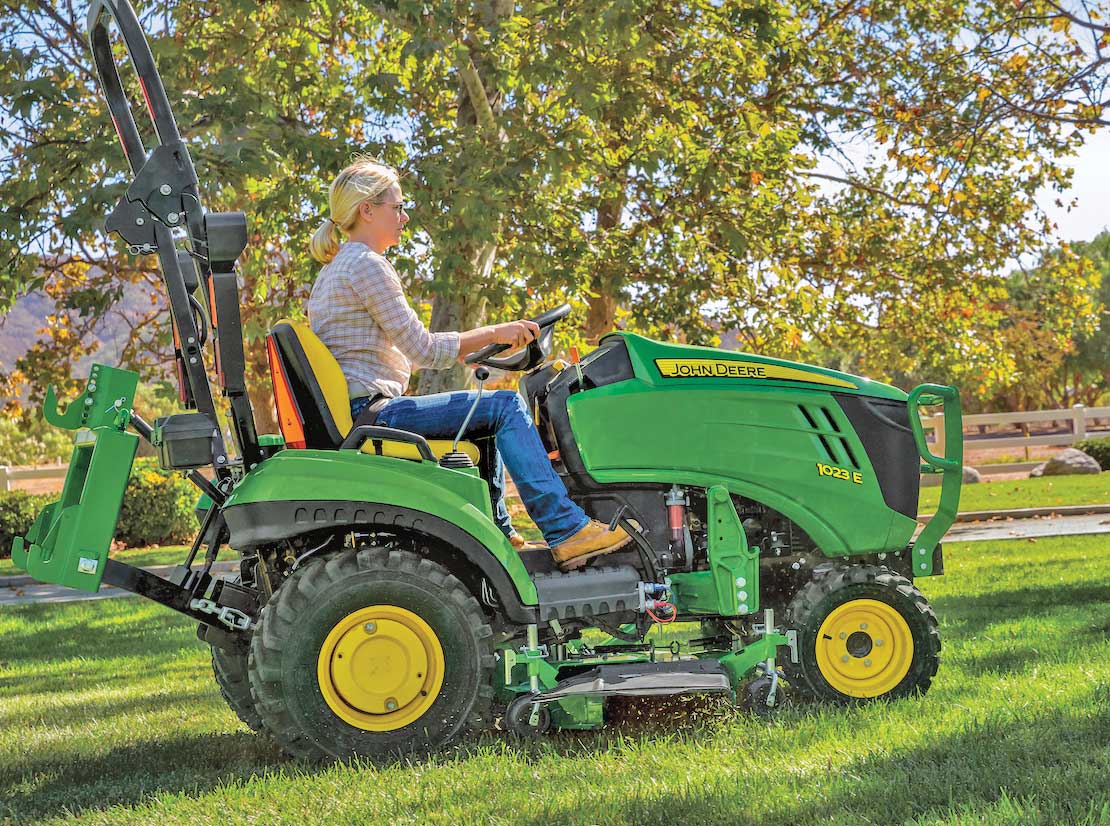Tractor Tires: Need Advice on Maintenance? Want New Wheels? Two Experts Weigh In
Without tires, your utility tractor isn’t going anywhere. Those four big black rubber wheels enable propulsion, traction, floatation and ultimately efficiency. Selecting the right group of tires is just as important as maintenance. Example: If the treads are worn down to 50 percent or less, or if the tires are starting to show signs of dry rot — cracks in the treads and sidewalls, brittleness, faded color — it’s time to replace them. Front tires tend to wear faster than rear tires, so keep an eye on them. It’s best to replace tires before you need to, otherwise you could have a tire failure at the worst possible moment. That’s just one piece of tractor tire advice. Here comes so more…
John Deere: Mark Davey, Go-To-Market Manager, Compact Utility Tractors

Operating and Maintenance Advice:
Each tread pattern will wear differently depending on the design of the tire and the job you are doing. Operators should remember that operating regularly on hard surfaces will escalate tire wear. Additionally, it is important to call out that tire spin on any surface will escalate tire wear. Operators should engage the differential lock to avoid tire spin. Checking your tire pressure regularly is important. Improper inflation, too much or too little, can impact your floatation in softer conditions, or cause irregular wear on harder surfaces. To keep you up and running on the job, always maintain proper inflation per your operator’s manual or tire manufacturer specifications.
Product Spotlight:
Our 1 series John Deere Sub Compact Utility Tractors offer three tire options: Turf Tread Pattern, Industrial Tread Pattern and Radial Turf Tread Pattern. Turf tires are ideal for those wanting to mow a manicured lawn and are looking to minimize the possibility of turf damage or disruption. Industrial tires are a better alternative for those doing regular loader work, as it provides more traction and is our most popular due to their versatility and are ideal for tougher jobs requiring more traction such as loader work. Radial Turf Tread tires are the perfect hybrid between our other tire offering, allowing for lower ground pressure, which results in less turfing, and include breaker bars that allow for shedding of snow and ice while the wider footprint makes these tires ideal for loader work and mowing applications.
Titan: Scott Sloan, Ag Product Manager

Buying Advice:
Getting the desired performance, longevity and cost-per-hour out of a tire starts with selecting the right tire for the job. You should choose a tread design that allows the machine to perform to the best of its abilities in your particular application. For compact tractors, that could be an R1W in wet soil, an R4 on concrete or an R3 for landscaping. If you’re going to run in a variety of ground conditions, then consider a hybrid tire that includes elements of all three tread designs. Also consider the ongoing support you’ll receive from your dealer and the tire manufacturer. Tires are often a top wear-part expense for a fleet. That means they also offer one of the greatest opportunities to reduce costs, but only if properly managed. Look for a tire manufacturer or dealer that will help you create a tire management plan.
Product Spotlight:
The Goodyear R14T from Titan is a crossover tire line designed to perform in a variety of conditions. The industry-unique hybrid of different tread styles allows owners of compact tractors to enjoy the benefits of ag, turf and industrial tire designs. That means no more having to choose between those tread designs — R-1 (ag), R-3 (turf) or R-4 (industrial) — when picking a new compact tractor or changing out tires and wheels based on the application. With the R14T tire, customers get the traction and cleaning features of an R-1 with the wear and ride features of an R-4, along with the lessened ground disturbance of an R-3. From hard concrete surfaces to softer soils, snow and sensitive turf, the R14T is designed to perform in any conditions. The R14T is available in over 30 sizes, making it suitable for any compact tractor on the market.
Keith Gribbins is publisher of Compact Equipment.
For reprint and licensing requests for this article, please click here.
